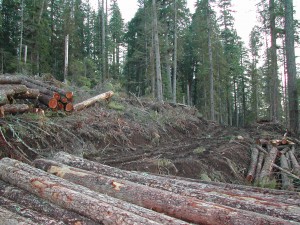By Bob Ferris
The general public tends not to gravitate to the complicated. That is one of the reasons that relatively few get engaged in the federal farm bills or in energy policy in spite of the critical importance of both those entities to our health, wealth and happiness. The end result is that the debates around these topics are largely led by those economic sectors that benefit from the very government largess they help to inject into these programs and the associated cloak of complexity which marks these undertakings as “off limits” as effectively as a gang tag.
The same is true for the so-called O&C lands, the recovered land gift from the long defunct Oregon and California Railroad. But for all Oregonians this is an important and timely subject. We all need to shrug off our politically acquired attention deficit disorder and get on this one.
This 2.7 million-acre cartographic checkerboard which forms the vibrant core of western Oregon’s publicly-held natural wealth has been both blessing and curse since the late-1930s. Here sylvan destruction and the demolition of the associated wildlands and ecological services were inextricably tied to the creation of a revenue stream through the 1937 O&C Act.
Certainly it was seen by many as a boon. But in hindsight—as we look at the ultimate impact on anadromous fisheries and other vulnerable species wrought by the perversely incentivized mowing of mature forests as well as its retarding impact on the responsible evolution of county tax structure in O&C counties—we really have to wonder at its wisdom and benefit. And now we all stand in the wrack and ruin it has created pointing fingers and demanding answers and solutions, when what we really should be demanding is absolute courage and Teddy Roosevelt, Solomon and Susan B. Anthony-scale leadership. In short, we need a hero (Cue forest scenes, the music and Bonnie Tyler).
Certainly we have credible, caring and capable politicians who have served us well in the past on a number of fronts. But what we require here is someone or some group of people that will take this legacy catalyzed by an ill-advised grant to a poorly managed business and stirred vigorously by Depression era desperation and turn it into something truly magical. And this has to be done without digging back into the same sad bag of tricks that fostered the mess in the first place.
This person or group cannot see with eyes that recognize borders or jurisdictions as barriers to progress. Nowhere in their methodology can there exist the least hint of territorial sensitivity but—at the same time—they must be literately dipped and coated in a sheen of fairness, foresight, and justice and possessing a continence wed to the future with scant attachment to things nostalgic.
Our hero, heroine or superhero enclave has be a “cosmic kangaroo” in that they can only move forwards and not backwards. They cannot, for instance, take any steps rearwards on water quality or salmon and steelhead recovery. The same is true for moving the counties towards solvency and being more fiscally independent; it is critical for our hero to hold back benefits in the absence of sincere county level fiscal corrections in terms of economizing and moving towards taxation parity with the non-O&C counties.
And the hero has to send a clear message to the timber crew—in all its various forms—that they cannot expect the environmental, conservation, recreational (including hunters and anglers) communities to accept accelerated harvest regimes and diminished streamside protections in federal forests in the absence of balancing measures—on public as well as private lands—that insure continued protection and restoration of valued wildlands and wildlife.
Here too the hero has to manifest kangaroo-ness in moving the industry—at least when it comes to federal lands—towards a restorative function focused on correcting the past plantation patterns. If I am not clear here let me be: Restorative thinning on younger plantation stands is a viable option and clearcutting mature stands is not. This latter action would also include modifying or discontinuing county-level forest land tax incentives that act to create more plantations without the public good of herbicide and deer repellent-free stands with diverse understories and vibrant streamside filter systems.
Yes this is complicated with devilish details and I am also sorry for forcing Bonnie Tyler into your mental music repertoire, but this isn’t and cannot be about more logs from more places, which is what we would get if the interested public allowed itself to be driven away by the complexity of the situation. You need to get involved and if you start to lose focus I am sure that we could mention a certain song involving little people actors from the original Willie Wonka and the Chocolate Factory or from a ride in a famous amusement park that will help this issue stick in your mind longer. Get to it, our forests need you.


You must be kidding. You know nothing about management of fo
rests and forest ecosystems
However I do give you credit for knowing how to spread disinformation and how to pander to the environmental zealot religion. Without that you would have little to do.